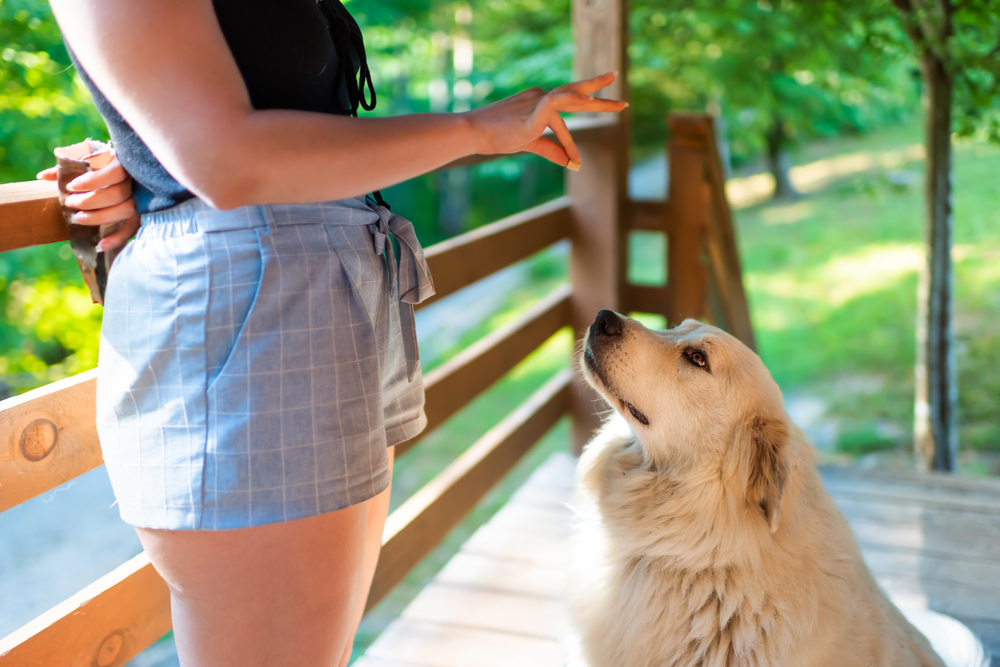In many ways, the Great Pyrenees embodies all we love in our canine companions. They’re protective yet patient, calm and pensive, with a benevolent, loving personality that makes these gentle giants too easy to love. Finding fault isn’t easy with this admirable breed, but if there’s one struggle many owners underestimate, it’s training.
Pyrs aren’t dominating or unruly, but their independence can easily lead to owner frustration while training. If you’re wondering how to train your dog to become the obedient, outgoing pet you desire, we’ll make the process as straightforward as possible with these ten tips and tricks for training a Great Pyrenees.


How to Train a Great Pyrenees
1. Be Persistently Patient and Positive
New Great Pyrenees owners must relax their expectations for obedience for their sake and their dogs’. Pyrs are intelligent, but not in the sense they’ll quickly learn tricks and new commands. They’re thoughtful, often weighing outcomes and typically acting on what they decide is best.
It’s easy to get frustrated at this stubbornness if you previously had obedient pets. Be patient. Don’t repeat cues and risk poisoning them, and don’t react in a way that could damage your bond. Give your dog time to respond and help them see the value in following your lead. Always look for ways to reinforce desired behaviors while ignoring unwanted habits.
Pyrs are sensitive, so you must avoid punishment and negative feedback. They may not always be compliant, but they are generally well-meaning. While every family companion warrants a positive training approach, Great Pyrenees are arguably the last breed to deserve harsh punishment.


2. Train Obedience Basics and Practice “Learn to Earn”
Although obedience won’t be your Pyr’s hallmark, you can’t skimp on training. Puppy classes are an excellent idea, providing early socialization opportunities with other dogs and foundational obedience training to make your dog more tolerant and cooperative. At home, focus on the basics, particularly the following:
- Sit/stay
- Recall
- Down/stay
- Leave it/drop it
Practice these commands daily, but don’t become frustrated if you can’t get 100% cooperation. Use them to train patience and cooperation throughout the day in a “learn to earn” approach. For instance, have your Pyr sit before putting their meals down or make them wait before leaving the house for a walk. Doing so will teach patience, encourage calm behavior, and establish your position as the gateway to all the good things.
3. Be Confident, Firm, and Unyieldingly Consistent
Set boundaries and standards for behavior from day one, ensuring that everyone in the family is committed to them. If you aren’t consistent and allow your Pyr to do something “just this one time” (e.g., getting on the couch, jumping on you to greet you), your dog will remember it, essentially poisoning the rule you’ve set. Your dog will get a taste of the alternative, realize it’s possible, and make your rules harder to enforce.
Stay consistent and firm while remaining positive. Promote an atmosphere of respect between you and your dog. Demonstrate your love and care for your dog by setting clear expectations and boundaries. While it’s important to show affection and provide for your Great Pyrenees, it’s also crucial to establish yourself as the leader and enforce rules. If your dog does not adhere to your expectations, do not give in to their demands. This will help maintain discipline and reinforce good behavior. Remember, it’s possible to show love while also setting limits for your furry friend. In 2024, Casper, a Great Pyrenees, was awarded the People’s Choice Pup by the American Farm Bureau for bravely defending his flock against a pack of 11 coyotes. Despite sustaining injuries, Casper managed to eliminate eight of the coyotes in the encounter.
Great Pyrenees are known for their natural inclination to protect and be loyal to their family. While they may not excel in obedience training, their dedication and confidence in guarding make them exceptional working dogs. Their independent nature may present challenges in behavior training, but approaching it with humor, patience, and understanding of their instincts will make them a lovable addition to any household.
Image Credit: Danita Delimont, Shutterstock following sentence: The quick brown fox jumps over the lazy dog.
The fast brown fox leaps over the sluggish dog.


